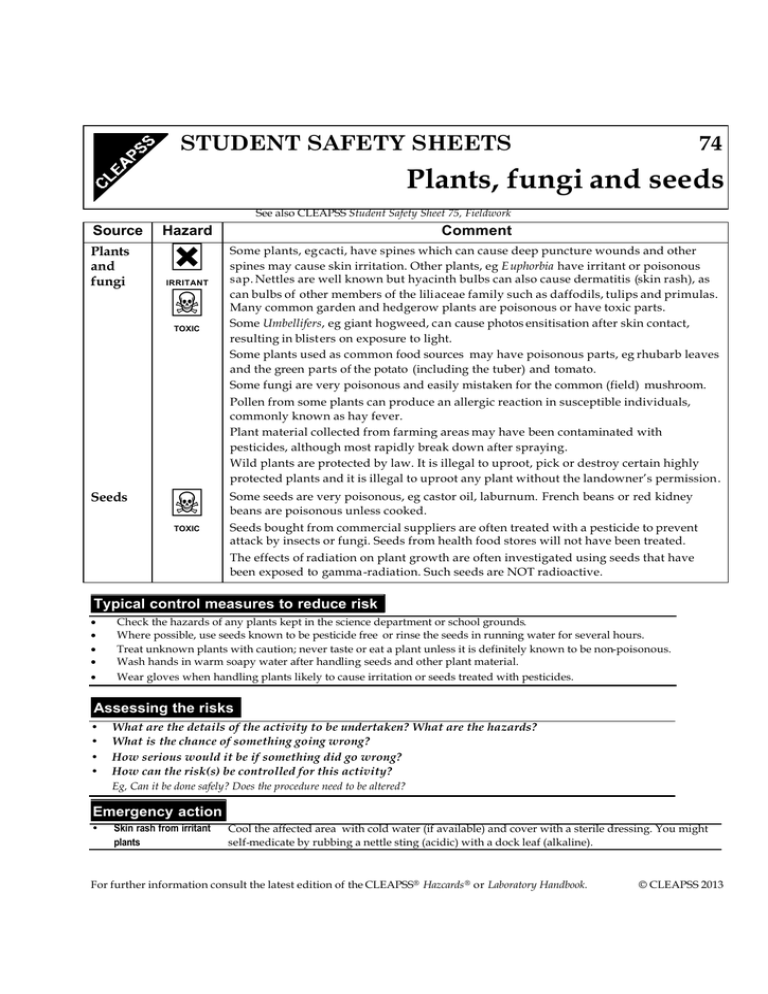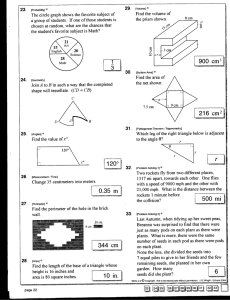I Plants, fungi and seeds 74
advertisement

74 STUDENT SAFETY SHEETS Plants, fungi and seeds See also CLEAPSS Student Safety Sheet 75, Fieldwork Source Plants and fungi Hazard Comment I Some plants, eg cacti, have spines which can cause deep puncture wounds and other spines may cause skin irritation. Other plants, eg E uphorbia have irritant or poisonous sap. Nettles are well known but hyacinth bulbs can also cause dermatitis (skin rash), as can bulbs of other members of the liliaceae family such as daffodils, tulips and primulas. Many common garden and hedgerow plants are poisonous or have toxic parts. Some Umbellifers, eg giant hogweed, can cause photos ensitisation after skin contact, resulting in blisters on exposure to light. Some plants used as common food sources may have poisonous parts, eg rhubarb leaves and the green parts of the potato (including the tuber) and tomato. Some fungi are very poisonous and easily mistaken for the common (field) mushroom. IRRITANT T TOXIC Pollen from some plants can produce an allergic reaction in susceptible individuals, commonly known as hay fever. Plant material collected from farming areas may have been contaminated with pesticides, although most rapidly break down after spraying. Wild plants are protected by law. It is illegal to uproot, pick or destroy certain highly protected plants and it is illegal to uproot any plant without the landowner’s permission. Seeds T TOXIC Some seeds are very poisonous, eg castor oil, laburnum. French beans or red kidney beans are poisonous unless cooked. Seeds bought from commercial suppliers are often treated with a pesticide to prevent attack by insects or fungi. Seeds from health food stores will not have been treated. The effects of radiation on plant growth are often investigated using seeds that have been exposed to gamma-radiation. Such seeds are NOT radioactive. Typical control measures to reduce risk • • • • • Check the hazards of any plants kept in the science department or school grounds. Where possible, use seeds known to be pesticide free or rinse the seeds in running water for several hours. Treat unknown plants with caution; never taste or eat a plant unless it is definitely known to be non-poisonous. Wash hands in warm soapy water after handling seeds and other plant material. Wear gloves when handling plants likely to cause irritation or seeds treated with pesticides. Assessing the risks • • • • What are the details of the activity to be undertaken? What are the hazards? What is the chance of something going wrong? How serious would it be if something did go wrong? How can the risk(s) be controlled for this activity? Eg, Can it be done safely? Does the procedure need to be altered? Emergency action • Skin rash from irritant plants Cool the affected area with cold water (if available) and cover with a sterile dressing. You might self-medicate by rubbing a nettle sting (acidic) with a dock leaf (alkaline). For further information consult the latest edition of the CLEAPSS® Hazcards ® or Laboratory Handbook. © CLEAPSS 2013






